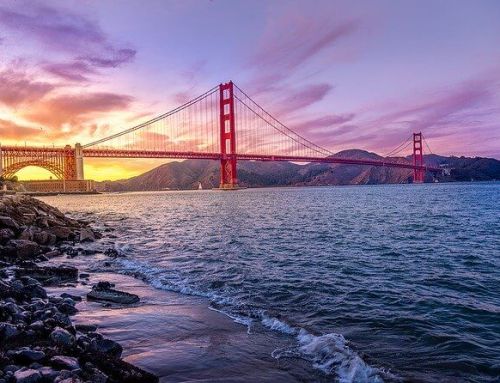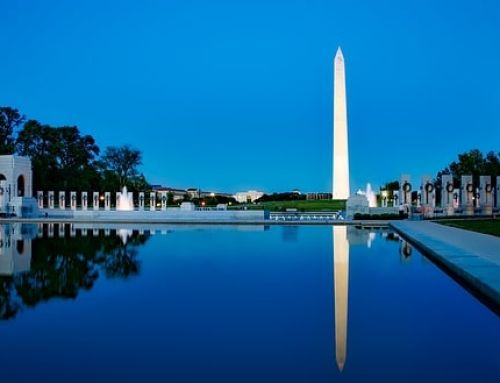Grand Canyon: what to see in the National Park
09 Dec 13:45

The Grand Canyon is one of the most beautiful parks in the United States, with up to six million tourists each year. As a result, it is not unexpected that UNESCO designated it as part of humanity’s global heritage in 1979.
Theodore Roosevelt, the same American president, described it as “beyond all comparison and description” and a marvel “without peer in the entire globe.” Without a doubt, if you enjoy nature and have the opportunity, this natural structure is well worth a visit.
This article will provide you with important information to help you plan your trip to the Grand Canyon. We will talk about the best time to visit, the easiest way to cross it, and the most intriguing things in the park.
Grand Canyon where it is located and the formation of the park
The Grand Canyon and its surrounding park are located in Northwestern Arizona, which is in the Southwestern United States. The Canyon is nothing more than a canyon of the Colorado River that stretches for about 5000 kilometres.
However, the park’s surface cannot be viewed in its whole, and travellers may only visit a few key sites, as we shall discover later. The rest of the park is primarily inaccessible wilderness.
The park is fairly secluded from the larger cities that surround it. If you wish to go, we recommend that you arm yourself with patience and drive to the Grand Canyon. The following are the travel times from the major adjacent cities:
- Phoenix : 3 1/2 hours via I-17 North road;
- Las Vegas : 4 1/2 hours via I-40 East;
- Albuquerque : 6 hours via I-40 West;
- Los Angeles : 7 hours via I-40 East;
- Salt Lake City – 8 hours via I-1;5 East
- Denver : 11 hours via I-70 West.
Park hours vary depending on location and season. The ticket is valid for seven days and costs the following to access the national park:
- $35 if accessed by private car;
- $30 with motorcycles;
- $20 if accessed by Grand Canyon Railway , foot, bike, shuttle, and river rafting vehicles.
What climate and temperatures will you find at the Grand Canyon?
The climate and temperatures of the park are similar to those in Arizona, with particularly hot and humid summers. Also, keep in mind that the temperature varies greatly between summer and fall.
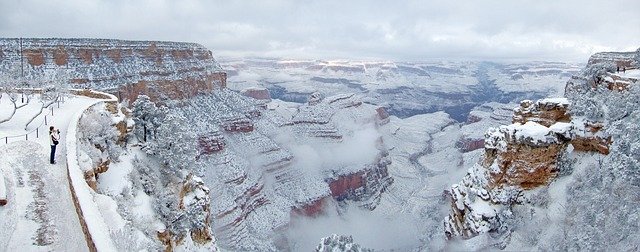
The Grand Canyon covered in snow
- Winter (November-March): A portion of the park is open throughout the winter, and the snow-capped peaks of the Canyon provide a spectacular sight. However, be wary of the regular storms and showers. Even the temperatures, with an average maximum of about 7°C and a low of -7°C, might be prohibitive.
- Summer (May-September): Summer in the park is unmistakably hot and muggy. In fact, temperatures can soar to deadly levels for unprepared travellers. This season’s Grand Canyon weather can be challenging. Storms, high winds, and lightning are common. Furthermore, heavy rains can trigger flash floods and landslides. Take note of the temperature variation: it can range from 40°C during the day to 9°C at night.
- Spring (March-May) and fall (September-November): the climate is more unpredictable throughout these seasons, although the temperatures are more comfortable than in summer or winter. April and May are windy months, with snowfall possible in March and October. Temperatures in the canyon’s surroundings range from 0 to 17°C. Inside the canyon, however, temperatures range from 13 to 28°C.
Grand Canyon: When to go for the best experience?
Given these climatic qualities, spring and fall are unquestionably the ideal times to explore the park. In reality, despite the rare bout of severe weather, the temperatures are softer and more comfortable, and the most of the attractions are open all day.
It’s no accident that these are the busiest times of year at the park. If you wish to camp here, you will need to get a permission for an overnight stay in advance.
What to see during your visit? The main attractions of the National Park
The Grand Canyon National Park is vast, and visiting it might take many days. However, if you just have a limited amount of time for your stay, we recommend that you focus on the attractions listed below.
The South Rim or southern part of the park
Our advice is to begin your tour at the park’s southern section. This is, in fact, the most popular with tourists and the one with the greatest attractions. It is also easily accessible from both the south and the north.
Hermit Road is arguably the most popular tourist path. This gorgeous 11-kilometer circuit is accessible all year by foot, bike, shuttle, and private tour. In the winter, however, it is also feasible to go by private vehicle.
We propose the following panoramic viewpoints along the path:
- Trailview Overlook
- Maricopa Point
- Powell Point
THE VILLAGE AT THE ENTRANCE TO THE PARK
Grand Canyon Village, located near the park’s southern gate, is a genuine fortification. Here you will discover information, exhibitions, and tiny museums to help you prepare for your visit. We especially encourage going to:
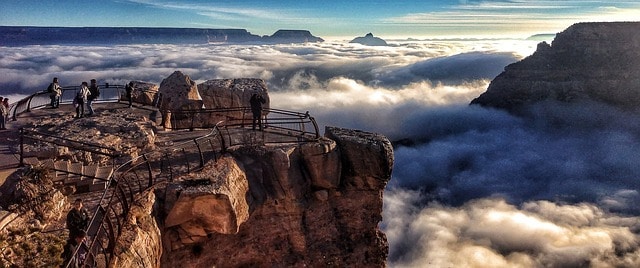
Mather Point
- Kolb Studio, the Kolb brothers’ original house, which dates back to 1904 and is now a museum. Interesting photographic exhibits are exhibited here on a regular basis.
- If you wish to camp in the park, the Backcountry Information Center will be your one-stop shop. There is also information about trips in the park’s hinterland.
- However, Verkamp’s Visitor Center is the finest site to learn more about the community’s century-old history.
- The Yavapay Geological Museum provides interactive, three-dimensional maps that can help you understand more about the formation and history of the Grand Canyon.
- The only way to get to the Mather Point overlook is from the Village.
- The park’s northern entrance is at Desert View. Aside from that, the Desert View is a worthwhile destination. Among its key sites of interest are:
- Mary Jean Colter created the Desert View Watchtower, which was influenced by ancient pueblos. You will be able to enjoy a beautiful perspective of the whole Canyon and the Painted Desert from here.
- Tusayan Museum and Ruins, about 5 kilometres west of the Desert View gate. This section contains fascinating facts on the lives and histories of the indigenous inhabitants of this region. The remnants of an old pluebos settlement are also on display.
Grand Canyon Skywalk and Canyon West Park
If you are not frightened of heights and want to enjoy an unforgettable experience dangling over the Grand Canyon, the Skywalk is a must-see. This horseshoe-shaped platform hangs 360 metres over the Canyon rock wall, 21 metres above the ground.
This extremely short movie, created by the Skywalk’s manager, Grand Canyon West, conveys the uniqueness of this attraction:
The indigenous Hualapai tribe commissioned the project, which was finished in 2007. The project is built of translucent material, allowing visitors to enjoy one of the Canyon’s greatest vistas.
HOW TO VISIT THE SKYWALK?
To visit the Skywalk, you must enter the Canyon from the west side. As a result, you will have two alternatives for the visit:
- The most convenient alternative is to join one of the Grand Canyon walks. Package excursions often include hotel pickup and an explanation-led tour of the Skywalk. Breakfast, lunch, and beverages are normally included in the price. However, keep in mind that the majority of trips leave from Las Vegas.
- Alternatively, you can go on your own visit. However, keep in mind that driving to the Skywalk will be impossible in this situation. As a result, you must direct the navigator to Grand Canyon West Airport, 5001 Diamond Bar Road, Peach Springs, AZ 86434. It will subsequently be essential to park and take advantage of the shuttle service.
COST TO VISIT THE SKYWALK
The Grand Canyon National Park does not include the Skywalk. As a result, you must purchase a separate Grand Canyon West ticket in order to visit.
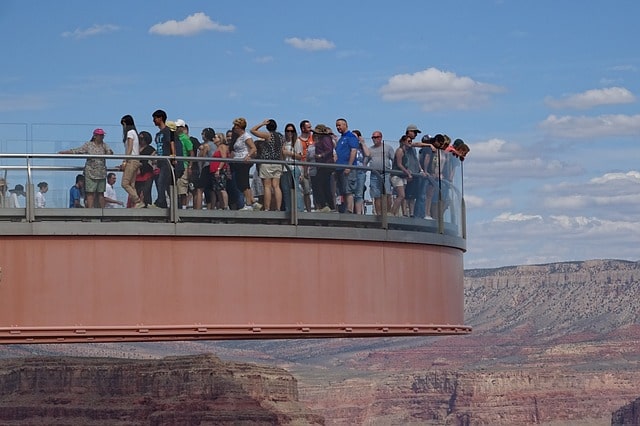
The Skywalk
Each General Admission Ticket with Skywalk Add-On costs around $80 and asks you to pick your preferred day and hour of entrance. Remember that the General Admission Ticket does not guarantee access to the Skywalk; thus, an additional cost must be paid.
You can choose whether or not to visit additional West Canyon attractions at the time of purchasing. As an example:
- Tour of Separation Canyon ($304);
- Emery Falls excursion ($305), which also includes a helicopter trip;
- The Historical Float Tour ($244) is a two-hour river trip to Guano Point.
North Rim
The northern section of the park is unquestionably the least visited by tourists. If you just have a few hours to see the Grand Canyon, keep in mind that the two rims are 4 hours apart. As a result, it will be impossible to see both in a single day, and if you must pick, we recommend that you prioritise the southern side.
Also, take in mind that this Rim is not accessible all year. If you wish to go, be sure you go at these times:
- from 15 May to 15 October: the park, as well as the information centre, restaurants, and camping, are open all day throughout these months.
- From October 15 to November 31, the park is only open from sunrise to sunset, and camping is not permitted.
THE ATTRACTIONS OF THE NORTHERN SLOPE
While this isn’t the most popular region of the park, there are various paths and overlooks to explore. The following are some must-see sights on the northern slope:
- The Bright Angel Trail leads to the Bright Angel Lookout, which provides an excellent view of the canyon. The trail is one of the shortest and easiest to follow, covering less than 1 kilometre in around 30 minutes.
- The Cape Royal Road is a 32-kilometer path with some good sights along the way. Among them, we particularly recommend:
- Point Imperial, the highest point in the Grand Canyon, is approximately five miles from the trailhead.
- the Walhalla Overlook, which provides a stunning view of the Colorado River Delta and access to the Walhalla Glades Pueblo
Practical tips for visiting Canyon Park
Visiting the Canyon is an unforgettable experience, but it may also be dangerous at times. As a result, we recommend that you thoroughly prepare for the expedition and adhere to our instructions.
First and foremost, ensure that you bring:
- depending on the intensity and duration of the visit, at least two litres of water;
- snacks and calorie-dense foods
- Even in fall and winter, use sunscreen and a wide-brimmed hat to protect yourself from the sun.
- first-aid kit, including duct tape and a pocket knife;
- Even if you don’t intend to remain until dusk, bring a torch and backup batteries. The cell phone flashlight does not give enough light, which causes the battery to deplete rapidly.
- as an emergency shelter, a light tarp;
- a map of the Grand Canyon;
- a whistle, as well as signal mirrors
The park is completely safe to visit, although some measures must be taken:
- Avoid travelling long distances in a single day.
- Keep an eye out for hypothermia, dehydration, and heat-related sickness symptoms.
- Swimming in the Colorado River is not recommended. Temperatures stay around 8 degrees Fahrenheit all year, and rapid currents can be dangerous.
Plan your excursion carefully:
- regular eating and drinking
- Every hour, sit for at least 10 minutes. Sit till you feel better if you are fatigued or run down.
- If you are too exhausted, remember that you may stay overnight at one of the Grand Canyon’s many hotels.
- Always communicate your whereabouts with your travelling buddies.
- Leave no traces or garbage in the park.
How to visit the park? Means of transport and excursions
If you don’t enjoy walking but still want to visit the park, there are numerous excursions available that will allow you to see the Canyon in a different way.
- Excursions with mules and donkeys: this form of trip may be organised both during the day and at night. These trips are ideal not just if you dislike walking, but also if you want to enjoy a unique experience. These trips are organised by Xanterra Parks & Resorts and Grand Canyon Trail Rides.
- Bike tours and bike rentals: From March to January, you may hire bicycles and prams or join one of the many scheduled trips. These services are provided by Bright Angels Bicycles and Café.
- Grand Canyon Helicopter & Air Trips: These tours leave from a tiny airstrip near the park’s South Rim entrance on a daily basis. Grand Canyon Helicopters provides helicopter tours, while Grand Canyon Airlines provides plane trips.
- Bus excursions: with this option, you may stay comfortably seated while a local guide provides information on the park’s history and geology. Xanterra Parks & Resorts offers frequent bus trips.
Visiting the Canyon: a unique and rewarding experience
The Canyon is not a typical tourist destination, but visiting it is a rewarding, though challenging, experience. As a result, remember to meticulously organise your journey, taking all of the precautions outlined in this article on how to visit the Grand Canyon. If you still need to present a passport or an ESTA visa for your travel, please see the links below for further information.
We are confident that whether you travel by bus, helicopter, or bicycle, it will be a wonderful experience!
FIND OUT MORE:
Return to the home page.
Concerned about ESTA? Please read our Frequently Asked Questions section.


